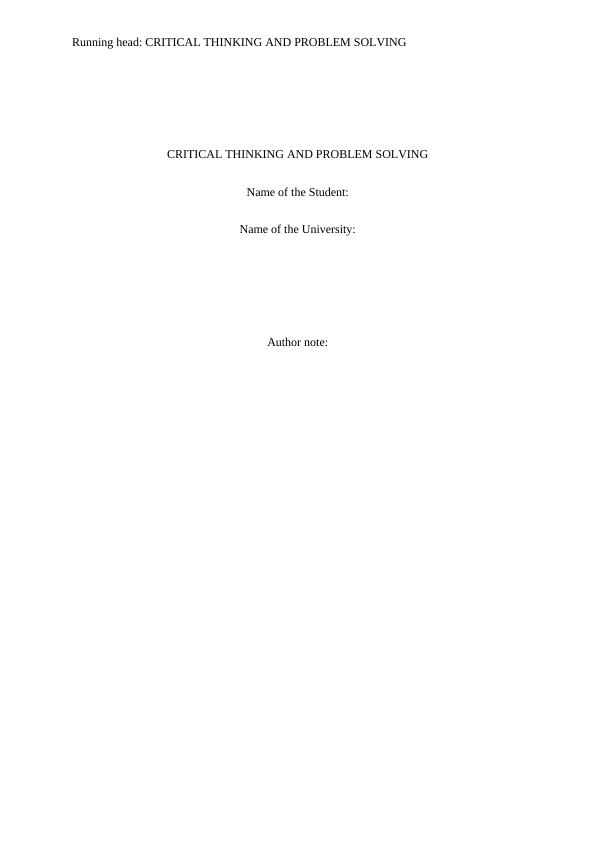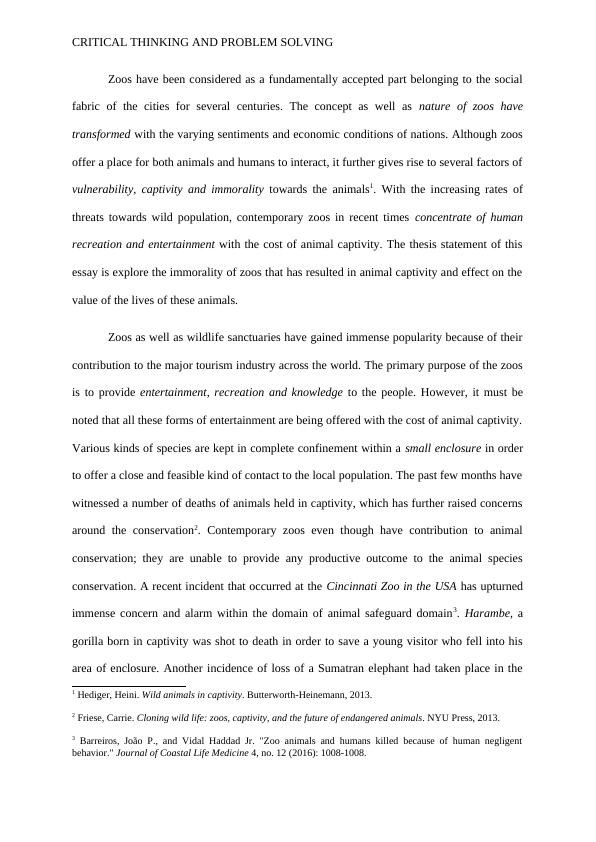The Immorality of Zoos: Animal Captivity and Its Effects
Added on 2023-06-13
6 Pages1711 Words181 Views
Running head: CRITICAL THINKING AND PROBLEM SOLVING
CRITICAL THINKING AND PROBLEM SOLVING
Name of the Student:
Name of the University:
Author note:
CRITICAL THINKING AND PROBLEM SOLVING
Name of the Student:
Name of the University:
Author note:

CRITICAL THINKING AND PROBLEM SOLVING
Zoos have been considered as a fundamentally accepted part belonging to the social
fabric of the cities for several centuries. The concept as well as nature of zoos have
transformed with the varying sentiments and economic conditions of nations. Although zoos
offer a place for both animals and humans to interact, it further gives rise to several factors of
vulnerability, captivity and immorality towards the animals1. With the increasing rates of
threats towards wild population, contemporary zoos in recent times concentrate of human
recreation and entertainment with the cost of animal captivity. The thesis statement of this
essay is explore the immorality of zoos that has resulted in animal captivity and effect on the
value of the lives of these animals.
Zoos as well as wildlife sanctuaries have gained immense popularity because of their
contribution to the major tourism industry across the world. The primary purpose of the zoos
is to provide entertainment, recreation and knowledge to the people. However, it must be
noted that all these forms of entertainment are being offered with the cost of animal captivity.
Various kinds of species are kept in complete confinement within a small enclosure in order
to offer a close and feasible kind of contact to the local population. The past few months have
witnessed a number of deaths of animals held in captivity, which has further raised concerns
around the conservation2. Contemporary zoos even though have contribution to animal
conservation; they are unable to provide any productive outcome to the animal species
conservation. A recent incident that occurred at the Cincinnati Zoo in the USA has upturned
immense concern and alarm within the domain of animal safeguard domain3. Harambe, a
gorilla born in captivity was shot to death in order to save a young visitor who fell into his
area of enclosure. Another incidence of loss of a Sumatran elephant had taken place in the
1 Hediger, Heini. Wild animals in captivity. Butterworth-Heinemann, 2013.
2 Friese, Carrie. Cloning wild life: zoos, captivity, and the future of endangered animals. NYU Press, 2013.
3 Barreiros, João P., and Vidal Haddad Jr. "Zoo animals and humans killed because of human negligent
behavior." Journal of Coastal Life Medicine 4, no. 12 (2016): 1008-1008.
Zoos have been considered as a fundamentally accepted part belonging to the social
fabric of the cities for several centuries. The concept as well as nature of zoos have
transformed with the varying sentiments and economic conditions of nations. Although zoos
offer a place for both animals and humans to interact, it further gives rise to several factors of
vulnerability, captivity and immorality towards the animals1. With the increasing rates of
threats towards wild population, contemporary zoos in recent times concentrate of human
recreation and entertainment with the cost of animal captivity. The thesis statement of this
essay is explore the immorality of zoos that has resulted in animal captivity and effect on the
value of the lives of these animals.
Zoos as well as wildlife sanctuaries have gained immense popularity because of their
contribution to the major tourism industry across the world. The primary purpose of the zoos
is to provide entertainment, recreation and knowledge to the people. However, it must be
noted that all these forms of entertainment are being offered with the cost of animal captivity.
Various kinds of species are kept in complete confinement within a small enclosure in order
to offer a close and feasible kind of contact to the local population. The past few months have
witnessed a number of deaths of animals held in captivity, which has further raised concerns
around the conservation2. Contemporary zoos even though have contribution to animal
conservation; they are unable to provide any productive outcome to the animal species
conservation. A recent incident that occurred at the Cincinnati Zoo in the USA has upturned
immense concern and alarm within the domain of animal safeguard domain3. Harambe, a
gorilla born in captivity was shot to death in order to save a young visitor who fell into his
area of enclosure. Another incidence of loss of a Sumatran elephant had taken place in the
1 Hediger, Heini. Wild animals in captivity. Butterworth-Heinemann, 2013.
2 Friese, Carrie. Cloning wild life: zoos, captivity, and the future of endangered animals. NYU Press, 2013.
3 Barreiros, João P., and Vidal Haddad Jr. "Zoo animals and humans killed because of human negligent
behavior." Journal of Coastal Life Medicine 4, no. 12 (2016): 1008-1008.

CRITICAL THINKING AND PROBLEM SOLVING
disreputable park reserve located in Indonesia. All these unfortunate incidents have given rise
to several debatable issues related to the lack of security and protection towards the animals
as well as the people visiting these animal reserves. However, several zoos can recognized
the concern regarding the insufficient space in order to engage in effective breeding
programmes for larger mammals.
The core immoral practice that is being performed by the contemporary zoos is
keeping the animal species in an alienated and isolated environment, whereby causing severe
restrictions to their liberty and independence. Animals living in natural habitat can develop
their own social orders and further behave in the ways, which are expected from them.
Restricting wild animals within a limited space like zoos sabotage their natural pattern as well
as their lifecycles4. These species further experience a significant environmental as well as
change in their habitat. Animals in several zoos fail to have the proper access to vegetation
and are therefore exposed to pollution. Although, the zoological industry has claimed to
spend a great amount of cost and expenditure in the process of stimulating a natural
environment for the animals, it has been reported that grasslands of several zoos contain
bacteria further causing harm to the species5. These incidents have raised much concern
within the human activists who have been seeking to accentuate the necessity of natural
environment or habitat for the animals, which would facilitate a normal development of
animals. The fundamental concept of depriving animals from their own habitat in order to
provide entertainment to humans must be regarded as unethical and immoral activity6.
Contemporary animal reserves function more as amusement parks rather than animal
4 Minteer, Ben A., and James P. Collins. "Ecological ethics in captivity: Balancing values and responsibilities in
zoo and aquarium research under rapid global change." ILAR journal54, no. 1 (2013): 41-51.
5 Hosey, Geoff, Vicky Melfi, and Sheila Pankhurst. Zoo animals: behaviour, management, and welfare. Oxford
University Press, 2013.
6 Webber, Sarah, Marcus Carter, Wally Smith, and Frank Vetere. "Interactive technology and human–animal
encounters at the zoo." International Journal of Human-Computer Studies98 (2017): 150-168.
disreputable park reserve located in Indonesia. All these unfortunate incidents have given rise
to several debatable issues related to the lack of security and protection towards the animals
as well as the people visiting these animal reserves. However, several zoos can recognized
the concern regarding the insufficient space in order to engage in effective breeding
programmes for larger mammals.
The core immoral practice that is being performed by the contemporary zoos is
keeping the animal species in an alienated and isolated environment, whereby causing severe
restrictions to their liberty and independence. Animals living in natural habitat can develop
their own social orders and further behave in the ways, which are expected from them.
Restricting wild animals within a limited space like zoos sabotage their natural pattern as well
as their lifecycles4. These species further experience a significant environmental as well as
change in their habitat. Animals in several zoos fail to have the proper access to vegetation
and are therefore exposed to pollution. Although, the zoological industry has claimed to
spend a great amount of cost and expenditure in the process of stimulating a natural
environment for the animals, it has been reported that grasslands of several zoos contain
bacteria further causing harm to the species5. These incidents have raised much concern
within the human activists who have been seeking to accentuate the necessity of natural
environment or habitat for the animals, which would facilitate a normal development of
animals. The fundamental concept of depriving animals from their own habitat in order to
provide entertainment to humans must be regarded as unethical and immoral activity6.
Contemporary animal reserves function more as amusement parks rather than animal
4 Minteer, Ben A., and James P. Collins. "Ecological ethics in captivity: Balancing values and responsibilities in
zoo and aquarium research under rapid global change." ILAR journal54, no. 1 (2013): 41-51.
5 Hosey, Geoff, Vicky Melfi, and Sheila Pankhurst. Zoo animals: behaviour, management, and welfare. Oxford
University Press, 2013.
6 Webber, Sarah, Marcus Carter, Wally Smith, and Frank Vetere. "Interactive technology and human–animal
encounters at the zoo." International Journal of Human-Computer Studies98 (2017): 150-168.

End of preview
Want to access all the pages? Upload your documents or become a member.
